Okay, let’s be real here: it’s the holidays, and during the entirety of the WSET diploma, there was inevitably going to be at least one class that combined horribly with a hangover, and that day was today. I’m stubborn and quasi-meticulous: I’ve never missed a class nor have I ever not written about a wine we tried, but I just don’t have the willpower to give birth to separate posts this time around. Not that anyone’s really counting on me, anyways. Insert booing crowd here.
The last workshop we had consisted of one flight of three wines and some written practice. Today consisted of two flights of wine and no written practice (thank the gods), and we promised our instructor that we would practice on our own as if we were promising our parents to not have a house party while they were gone for a week. I only mention my hangover because my acid radar was off the charts. I’m pretty sure I’m just dehydrated and salivating all over the place, or thinking about delicious things way too often.
For the exam, there are three different types of flights on which we can get challenged. The first kind involves common links between three wines, which may be partially stated, and it’s up to you to justify what you think the common thread is. For example, we may have to determine that the wines might all be Riesling, that they might all be from Italy, or that they might all be made by winemakers who wear hats. Okay maybe not that last one, but sometimes that’s what it feels like we’re trying to do. (Can I get a what what?!)
The second involves determining the quality levels of three different wines that come from the same region and are made up of the same grapes. We did this for our second flight today, basically, and it’s all about channelling Tyra Banks and ranking the wines in front of you.
The third kind is called “mixed bag”, and the head honchos are given permission to throw whatever they want at us. We could be given a Tokaji, an Australian Grenache, and a New Zealand Chardonnay, and we’d have to do our best to scribble down our answers through the tears and sobriety. Kind of like the wines I would end up choosing for our following practice flight the next day.
Our first flight consisted of three whites. If I were to quickly generalize the three, I would say that the first two were crisp, and to be frank, rather dull in comparison to the third wine, which was sweeter and more viscous. Chenin Blanc, I thought, with a partially willing soul, because I thought acid was higher than they purportedly were. I thought the middle one was some sort of overcropped version from who knows where. The third one had an earthy mushroom character that rooted me to Chenin, though I didn’t even consider Pinot Gris. Because I suck. Playing the hangover card. Who even wants to think about alcohol right now?
The hint we were given for the reds was that they were all from the same country and region of origin, and this time we were instructed to give detailed assessments on their quality levels instead of determining their origins. Of the five that showed up for class, it looked like we generally had the same thoughts on the wines: the first two were much superior to the third. All of us ranked the last wine as “acceptable”. Three of us ranked the first wine as “good” and the second as “very good”, while the other two switched their answers. The instructor for the week suggested that the first was actually “very good”, the second was “outstanding”, and the third was “good” instead of “acceptable”. I suppose we all channelled Kelly Cutrone instead of Tyra Banks.
Bah.
Wine #1: Villa Maria 2013 Pinot Gris
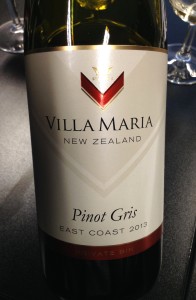 Quiet notes of mineral, green fruit, and citrus. Dry; medium-bodied. High acid, I said, but apparently it was medium minus. Same flavours on the palate, with an average length. Someone asked for a approximation to this the other day at the store: we eventually settled on something from BC.
Quiet notes of mineral, green fruit, and citrus. Dry; medium-bodied. High acid, I said, but apparently it was medium minus. Same flavours on the palate, with an average length. Someone asked for a approximation to this the other day at the store: we eventually settled on something from BC.
Eyes: clear, pale lemon, legs evident
Nose: clean, med- intensity, youthful, mineral, petrichor, green fruit, green apple, citrus, lemon, lime
Mouth: dry, med body, high acid (or med+, or med, or whatever…), med alcohol, med intensity, mineral, green fruit, green apple, pear, citrus, lemon, med finish
All in all: Good quality: the wine has balance between its fruit and its structure; the palate has a fair amount of intensity. The wine, however, is rather simple and also lacks some concentration and length. Drink now: not suitable for ageing or further ageing.
Producer: Villa Maria
Designation: N/A
Region: New Zealand
Sub-Region: Marlborough
Variety: Pinot Gris
ABV: 13.5%
Vintage: 2013
Tasted: December 15, 2014
Price: $19
Wine #2: Kris 2013 Pinot Grigio
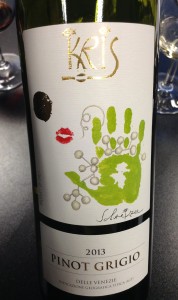 Generally consistent with my notes from the 2011 vintage, and most notably, acidity (I told you!). Less complex than the Villa Maria but also more focussed and finessed. This was the first wine I had, I believe, in class for the WSET Diploma, but I swear I liked it much more the first time around.
Generally consistent with my notes from the 2011 vintage, and most notably, acidity (I told you!). Less complex than the Villa Maria but also more focussed and finessed. This was the first wine I had, I believe, in class for the WSET Diploma, but I swear I liked it much more the first time around.
Eyes: clear, pale lemon, legs evident
Nose: clean, med- intensity, youthful, mineral, green fruit, green apple, stones
Mouth: dry, med- body, med+ acid, med- alcohol, med intensity, green apple, stones pear, hint citrus, med- finish
All in all: Acceptable (to good) quality: the wine is very simple, not giving much aroma or flavour on the nose or palate. This is emphasized by the imbalance on the palate between acid and flavour. The finish is lacking and concentration suffers as well. Drink now: not suitable for ageing or further ageing.
Producer: Kris
Designation: N/A
Region: Italy
Sub-Region: Veneto IGT
Variety: Pinot Grigio
ABV: 12.5%
Vintage: 2013
Tasted: December 15, 2013
Price: $19
Wine #3: Domaine Mersiol 2008 “Les Pierres Franches” Pinot Gris Frankstein
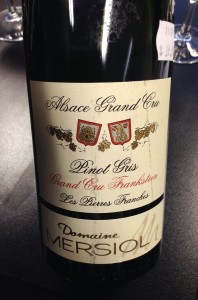 This was one of the first wines I blogged about when I was a bit younger in the wine industry, but the wine was a different vintage and didn’t have the “Les Pierres Franches” designation. Looks like I even thought it was made of Chenin Blanc then. Huh.
This was one of the first wines I blogged about when I was a bit younger in the wine industry, but the wine was a different vintage and didn’t have the “Les Pierres Franches” designation. Looks like I even thought it was made of Chenin Blanc then. Huh.
There was a lot more of that mushroom character than I remember, and there’s a little more acid than I thought there was. And perhaps it was because of the age, vintage, or designation, but I remember this wine being a lot more dry on the finish.
Eyes: clear, medium lemon, legs evident
Nose: clean, med+ intensity, developing, mushroom, dried apricot, stone fruit, mineral, peach, baked apple
Mouth: off-dry, med+ body, med acid, med+ alcohol, med+ intensity, mineral, mushroom, green fruit, baked apple, stone fruit, peach, medium finish
All in all: Very good quality: the wine has developed flavour characteristics that are quite complex, and the flavours on the palate are well-balanced with the acid levels and the residual sugar. Though the finish lacks in the slightest, the intensity on the palate makes up for it. Drink now: not suitable for ageing.
Producer: Domaine Mersiol
Designation: “Les Pierres Franches”
Region: France
Sub-Region: Alsace Grand Cru AOC
Variety: Pinot Gris
ABV: 14%
Vintage: 2008
Tasted: December 15, 2014
Price: $40
Wine #4: Château Fourcas Hosten 2005 Cru Bourgeois Supérieur
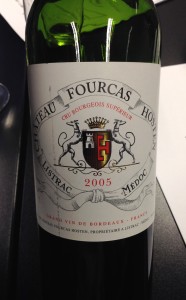 Strength in the complexity and developed fruit. Not as plush as the second, but marginally more finessed and much more mature.
Strength in the complexity and developed fruit. Not as plush as the second, but marginally more finessed and much more mature.
Eyes: clear, deep ruby, legs evident
Nose: clean, med+ intensity, developing, black fruit, blackberry, cassis, hint of grilled meat, spice, earth, hint of leather
Mouth: dry, med body, med acid, med+ fine tannins, med+ alcohol, med intensity, black fruit, black pepper, blackberry, earth, hint of game, medium length
All in all: Good (to very good) quality: the wine displays intense character on both the nose and the palate. The acidity is perhaps not perfectly balanced with the tannin and concentration, but the wine does show lots of complexity. Drink now: not suitable for ageing or further ageing.
Producer: Château Fourcas Hosten
Designation: N/A
Region: France
Sub-Region: Listrac-Médoc AOC, Bordeaux
Variety: Cabernet Sauvignon (53%), Merlot (47%)
ABV: 13%
Vintage: 2005
Tasted: December 15, 2014
Price: $40
Wine #5: Château Cos Labory 2010 5ème Cru Classé
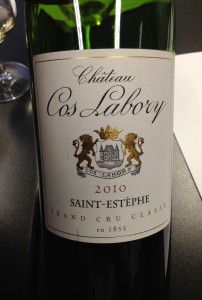 Intense berries, cassis, oak, and dried flowers on the nose. Only a medium body but it’s all muscle on the palate, with a big but stable structure.
Intense berries, cassis, oak, and dried flowers on the nose. Only a medium body but it’s all muscle on the palate, with a big but stable structure.
Eyes: clear, deep ruby, legs evident
Nose: clean, med+ intensity, youthful, earth, black pepper, dried flowers, plum, black fruit, blackberry, blueberry, smoke, oak
Mouth: dry, med body, med+ acid, pronounced fine tannin, med+ intensity, black fruit, blueberry, black fruit, blackberry, black pepper, dried flowers, oak, med+ finish
All in all: Very good (to outstanding) quality: the wine is intense and concentrated in both its aromas and flavours. Though the wine has a fairly present structure with med+ acid and pronounced fine tannins, the flavours show through the structure well. The finish is also relatively long. Can drink now, but has potential for ageing.
Producer: Château Cos Labory
Designation: N/A
Region: France
Sub-Region: Saint-Estèphe AOC, Haut-Médoc, Bordeaux
Variety: Cabernet Sauvignon (65%), Merlot (35%)
ABV: 14.5%
Vintage: 2010
Tasted: December 15, 2014
Price: $90
Wine #6: Château Grand Renom 2010
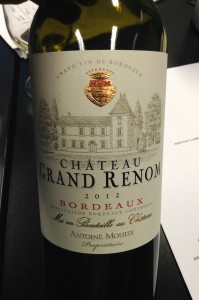 I hate to say it, but it’s the untuned cello equivalent to its untuned violin. I’m pretty sure everyone in the class thought it paled in comparison to the other two so much that the contrast in quality was much more evident. We all ranked it as acceptable quality, but it’s supposedly not as low in quality as we all thought.
I hate to say it, but it’s the untuned cello equivalent to its untuned violin. I’m pretty sure everyone in the class thought it paled in comparison to the other two so much that the contrast in quality was much more evident. We all ranked it as acceptable quality, but it’s supposedly not as low in quality as we all thought.
At first whiff, there’s a bit more of a jutting herbaceous note – but there’s also bit of a jammy hint, as if it was there to offset the greenness. Not into it but now I feel bad for laying into it.
Eyes: clear, deep ruby, legs evident
Nose: clean, med+ intensity, youthful, black fruit, blackberry jam, hint confection, cassis, hint herbaceousness, cassis
Mouth: dry, med- body, low acid, med+ chalky tannin, med alcohol, med- intensity, ripe black fruit, blackberry jam, cassis, med- finish
All in all: Acceptable (to good) quality: though the wine shows intensity on the nose, it’s quite disjointed on the palate. It’s not in balance, and the lack of intensity on the palate, combined with the low acid, makes the tannin much more evident. The wine also doesn’t have much complexity nor a substantial finish. Drink now: not suitable for ageing or further ageing.
Producer: Château Grand Renom
Designation: N/A
Region: France
Sub-Region: Bordeaux AOC
Variety: Merlot (70%), Cabernet Sauvignon (15%), Cabernet Franc (15%)
ABV: 13%
Vintage: 2012
Tasted: December 15, 2014
Price: $18
One Comment
Comments are closed.